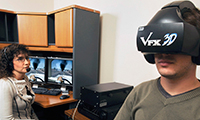Virtually Better
Virtually Better: A Novel Treatment for Phobias, Addictions, and Post-Traumatic Stress Uses Virtual Realities
The weather is lovely outside the room's large picture window–blue skies, birds singing, a calm, sunny day. Soon, however, the wind picks up and rain begins to splatter the panes. Low, booming thunder can be heard in the distance. At the storm's peak, lightning flashes, the wind howls, and the power fails. For anyone with a phobia of storms, these are the stimuli that set their heart racing and stomach churning. But this virtual environment is controlled by a therapist's computer keyboard and experienced through a headset.

Barbara Rothbaum, PhD
Virtual Reality Therapy (VRT) involves exposing clients to a computer-generated model of a fear-provoking situation until they become more comfortable with it. Virtually Better, Inc., founded in 1996, is known worldwide as a leader in the creation of virtual reality environments for use in the treatment of anxiety disorders such as fear of heights, fear of public speaking, and fear of flying, as well as treatment of post-traumatic stress disorder.
"Virtually Better provides an alternative to traditional exposure therapy, in which a patient is exposed to stimuli related to his fear in a controlled environment," says Laura Fritts, director of license and patent strategy at Emory's Office of Technology Transfer. "Traditional exposure therapy is expensive, inconvenient, and time-consuming since it involves placing both therapist and patient in the fear-provoking situation. For example, it would require patient and therapist going to the airport and traveling on a plan to treat fear of flying. Since therapists do not need to leave their offices, VRT provides several advantages over traditional exposure therapy. With Virtually Better solutions, therapists can treat patients in the office with greater convenience and lower costs and time."

Virtually Better Work Station
Professor of Psychiatry Barbara Rothbaum, PhD, who directs the Trauma and Anxiety Recovery Program at Emory's School of Medicine, was one of the pioneers of VRT in the early 1990s. Rothbaum, a clinical psychologist, and Larry Hodges, a computer scientist then at Georgia Tech, were principal investigators in the first published journal study on using virtual reality exposure for treating a phobia—in this case, the fear of heights.
"We had been taking patients up tall buildings and to the top of the parking garage for years, but we discovered that the virtual reality exposure translated into real life," Rothbaum says. "Seven out of ten people at the end of treatment were able to go into a real-life height situation." Realizing that they had a marketable product but no way to produce it, they formed the Atlanta-based company Virtually Better to develop, test, and market computer 3-D imaging software systems for virtual reality exposure therapy.
Today, researchers at Virtually Better help treat post-traumatic stress disorder in Afghanistan and Iraq War veterans, by using virtual scenes of war that aid these veterans in confronting memories they may be blocking out.
Virtually Better has created scenes of a glass elevator and a bridge to address fear of heights, an airplane cabin for fear of flying, and the thunderstorm for fear of severe weather. The treatment of substance addiction is being investigated as well, with scenes of a virtual bar and a virtual "crack house" used to help patients learn to resist drug and alcohol triggers and cravings. To treat post-traumatic stress, Virtually Better has programmed Vietnam scenes of helicopters and jungles, to help veterans confront memories they may be blocking out.
"When government agencies like the National Institutes of Health (NIH) or the Department of Defense fund a study, they don't want it to be just ivory tower research that ends up in journals–they want it to get out to the public and have an impact on people's lives," says Rothbaum.
"CalmCraft: A Deep Sea Voyage" is a recent project. It's an interactive computer game that helps children receiving medical treatment learn deep-breathing techniques to manage pain and anxiety. This biofeedback application features an audio "commander" who helps the child navigate a beautiful undersea world in a special "CalmCraft" submarine powered by controlled breathing–a developed skill the child can use in other stressful situations at the physician's office, at home, at school and other settings.
Today, Virtually Better is a leader in developing innovative technology solutions, such as virtual worlds and online tools, to enhance behavioral health care, training, and consultation practice.
Additional Emory Publications on Virtual Reality Theraphy
Emory News Center: Emory researchers report first findings of virtual reality exposure therapy for veterans with PTSD
Emory News Center: Study investigates virtual reality with a twist for fear of flying
Press News Center: PTSD - The invisible wounds of war